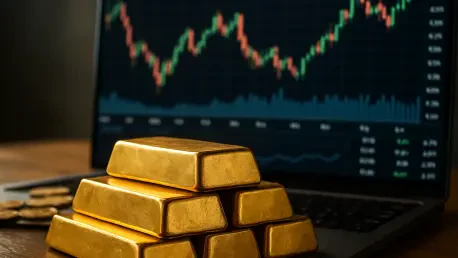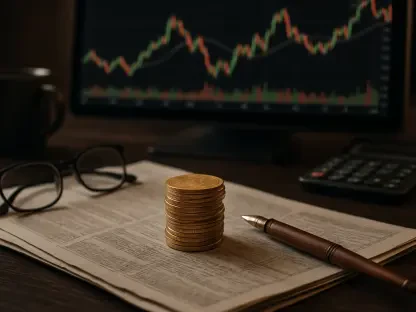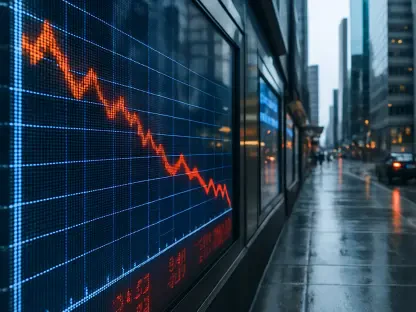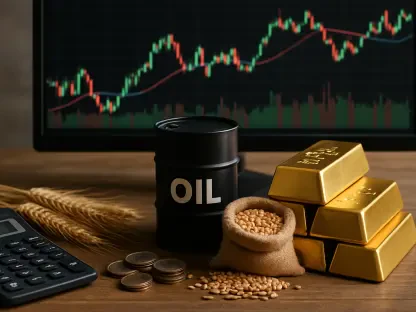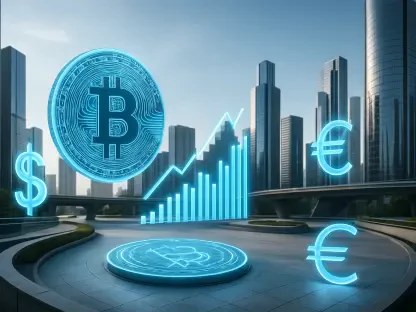In the midst of swirling economic uncertainty, the financial markets are grappling with mixed signals as they await critical insights from the Federal Reserve (Fed), while a federal government shutdown, now stretching into its seventh day, has halted the release of vital economic data, leaving investors and policymakers alike in a state of limbo. The much-anticipated Fed meeting minutes from September, expected to be released imminently, are poised to either clarify or further complicate the outlook on interest rates. Amid this backdrop, U.S. stock futures for major indices like the Dow Jones Industrial Average, S&P 500, and Nasdaq 100 are showing cautious gains, while gold prices are soaring to historic highs near $4,000 per ounce. This divergence between equity futures and the precious metal reflects a deeper tension in the markets, where optimism and anxiety coexist. As the Fed’s stance on monetary policy remains unclear, the reactions of these asset classes offer a window into investor sentiment and the broader economic landscape. This article delves into the nuanced responses of stock futures and gold, exploring how they mirror the uncertainty surrounding Fed decisions, the impact of missing data, and the interplay of risk and safety in turbulent times.
Cautious Stability in Stock Futures
The modest uptick in U.S. stock futures, with gains of approximately 0.2% across the Dow, S&P 500, and Nasdaq 100, suggests a tentative confidence among investors despite recent setbacks. This slight recovery follows a downturn on Tuesday, prompted by underwhelming earnings from a major technology firm that cast doubts on the profitability of sectors heavily tied to artificial intelligence (AI). While the numbers indicate a stabilizing market, the underlying mood appears to be one of restraint rather than exuberance. Investors seem to be adopting a wait-and-see approach, keenly aware that the forthcoming Fed minutes could either bolster hopes for continued rate cuts or reignite fears of tighter policy to curb inflation. The balance between these outcomes is delicate, as the absence of critical economic reports due to the ongoing government shutdown adds another layer of complexity to market predictions. This cautious stability in futures highlights a market that, while not in panic, is far from complacent, with participants bracing for potential shifts in monetary direction that could reshape investment strategies in the near term.
Beyond the immediate numbers, the steadiness in stock futures also reflects broader concerns about the sustainability of recent market rallies, particularly in technology-driven sectors. The AI boom, which has fueled significant gains over recent months, is now under scrutiny following reports of weaker-than-expected margins in key companies. This has sparked debates about whether the enthusiasm for AI represents genuine long-term value or if it risks becoming a speculative bubble. While some analysts argue that the sector’s growth is underpinned by solid fundamentals, others caution against overvaluation and market concentration. The muted reaction in futures suggests that investors are weighing these risks against the potential for Fed policy to provide a supportive backdrop through lower interest rates. Until clearer guidance emerges from the Fed minutes, the market appears content to hover in this holding pattern, balancing the allure of growth opportunities with the reality of economic and policy uncertainties that could dampen momentum.
Gold’s Meteoric Rise Amid Economic Fears
In stark contrast to the cautious optimism of stock futures, gold is experiencing a dramatic surge, with futures prices nearing a historic $4,000 per ounce. This remarkable climb, representing a 50% increase over the course of this year, marks the largest annual gain for the precious metal since 1979. The rally is driven by a confluence of factors, including heightened economic uncertainty exacerbated by the federal government shutdown and persistent geopolitical tensions. As a traditional safe-haven asset, gold has become a magnet for investors seeking protection against potential downturns, especially in an environment where trade policies and global instability add to the sense of unpredictability. The Fed’s recent rate cut has further fueled this demand, making gold a more attractive option compared to interest-bearing assets. This surge serves as a clear indicator of widespread anxiety, reflecting doubts about the stability of the U.S. economy and the ability of policymakers to navigate through turbulent waters without comprehensive data to guide their decisions.
The role of central banks and exchange-traded funds in driving gold’s ascent cannot be overstated, as their aggressive buying underscores a global shift toward safeguarding wealth amid uncertainty. Following the Fed’s decision to lower rates, these institutional players have ramped up their investments in gold, viewing it as a hedge against both inflation risks and potential economic slowdowns. The government shutdown, which has delayed critical reports like the September jobs data, only amplifies this flight to safety, as the lack of visibility into the economy’s health leaves markets on edge. Additionally, geopolitical frictions, including trade disputes under current U.S. leadership, contribute to the narrative of instability that gold thrives upon. Unlike stock futures, which suggest a measured hope for recovery, gold’s relentless upward trajectory paints a picture of deep-seated concern, positioning it as a barometer of fear in a financial landscape rife with unanswered questions about the Fed’s next moves and the broader economic outlook.
Fed Policy Challenges and Internal Divisions
At the heart of the market’s uncertainty lies the Fed itself, where internal divisions over monetary policy are creating a challenging environment for decision-making. Some officials, including new governor Stephen Miran, advocate for aggressive rate cuts to bolster economic growth, pointing to risks such as declining immigration and the potential impact of tariffs on trade. This perspective emphasizes the need for stimulus to counteract looming headwinds that could stifle expansion. However, others within the Fed, like Kansas City President Jeff Schmid, caution against excessive easing, warning that such measures could fuel inflation by enhancing corporations’ ability to raise prices. This split in viewpoints underscores a fundamental tension between supporting growth and maintaining price stability, a balance that is particularly difficult to strike without the full picture of economic conditions. The upcoming release of the Fed’s September minutes is seen as a critical moment that might reveal whether a consensus is forming or if disagreements will continue to cloud the policy outlook.
Compounding these internal debates is the significant obstacle posed by the federal government shutdown, which has disrupted the flow of essential economic data. Without access to key reports such as the September jobs numbers, the Fed is forced to operate with incomplete information, akin to navigating a complex course with limited visibility. This data blackout not only hinders the central bank’s ability to make informed decisions but also heightens uncertainty in financial markets, as investors lack the usual benchmarks to gauge economic health. The shutdown’s persistence, now in its seventh day, shows no immediate signs of resolution, with political gridlock further complicating the situation. As a result, the Fed’s policy deliberations carry even greater weight, with markets hanging on every word of the minutes for hints about future rate directions. This environment of uncertainty directly influences the divergent reactions of stock futures and gold, as investors hedge their positions between cautious equity exposure and the protective allure of precious metals.
Market Dynamics and the Risk-Safety Divide
The contrasting movements of stock futures and gold encapsulate a broader dynamic within financial markets, where the balance between risk and safety is being constantly recalibrated. The slight gains in futures for major U.S. indices point to a segment of investors who remain willing to bet on equities, perhaps anticipating that the Fed will lean toward accommodative policies to support growth. This tentative confidence is tempered by recent disappointments in the technology sector, where high expectations for AI-driven gains have been met with sobering realities about profitability. Despite these concerns, the stability in futures suggests that the market is not yet ready to abandon risk assets entirely, holding out hope that clarity from the Fed minutes could provide a catalyst for renewed momentum. This cautious approach reflects a nuanced stance, where the potential for economic recovery is weighed against the myriad uncertainties that could derail progress, from policy missteps to unforeseen geopolitical shocks.
On the other hand, gold’s unprecedented rally highlights a significant countercurrent of risk aversion that runs parallel to the equity market’s guarded optimism. As prices approach $4,000 per ounce, the precious metal has become a refuge for those wary of economic instability, driven by both domestic challenges like the government shutdown and international pressures such as trade disputes. This flight to safety is amplified by institutional demand, with central banks and funds stockpiling gold as a buffer against potential downturns. The stark difference between the modest upward tick in stock futures and the dramatic surge in gold prices illustrates a divided market sentiment, where some participants are prepared to ride out the uncertainty with riskier assets, while others seek the shelter of time-tested havens. This dichotomy underscores the pivotal role of Fed policy in shaping market direction, as the resolution of internal divisions and the eventual availability of economic data will likely determine whether risk or safety ultimately prevails.
Navigating the Uncertain Path Ahead
Reflecting on the recent market movements, it becomes evident that the financial landscape is marked by a fragile equilibrium, where stock futures hold steady with modest gains while gold soars to near-record levels. The federal government shutdown has deepened the fog of uncertainty by delaying critical economic data, leaving the Fed to grapple with policy decisions in the dark. Meanwhile, internal disagreements within the central bank over the pace of rate cuts have only added to the ambiguity that shapes investor behavior during this period.
Looking forward, the path to stability hinges on several actionable steps and considerations. Policymakers must prioritize resolving the shutdown to restore the flow of essential data, enabling more informed decisions that can guide markets with greater certainty. Investors, in turn, should focus on diversification, balancing exposure to equities with safe-haven assets like gold to mitigate risks in this unpredictable environment. Additionally, close monitoring of the Fed’s communications, starting with the September minutes, will be crucial for anticipating shifts in monetary policy that could sway market dynamics. As the interplay of risk and safety continues to define the financial arena, staying agile and responsive to emerging signals will be key to navigating the challenges and opportunities that lie ahead.
